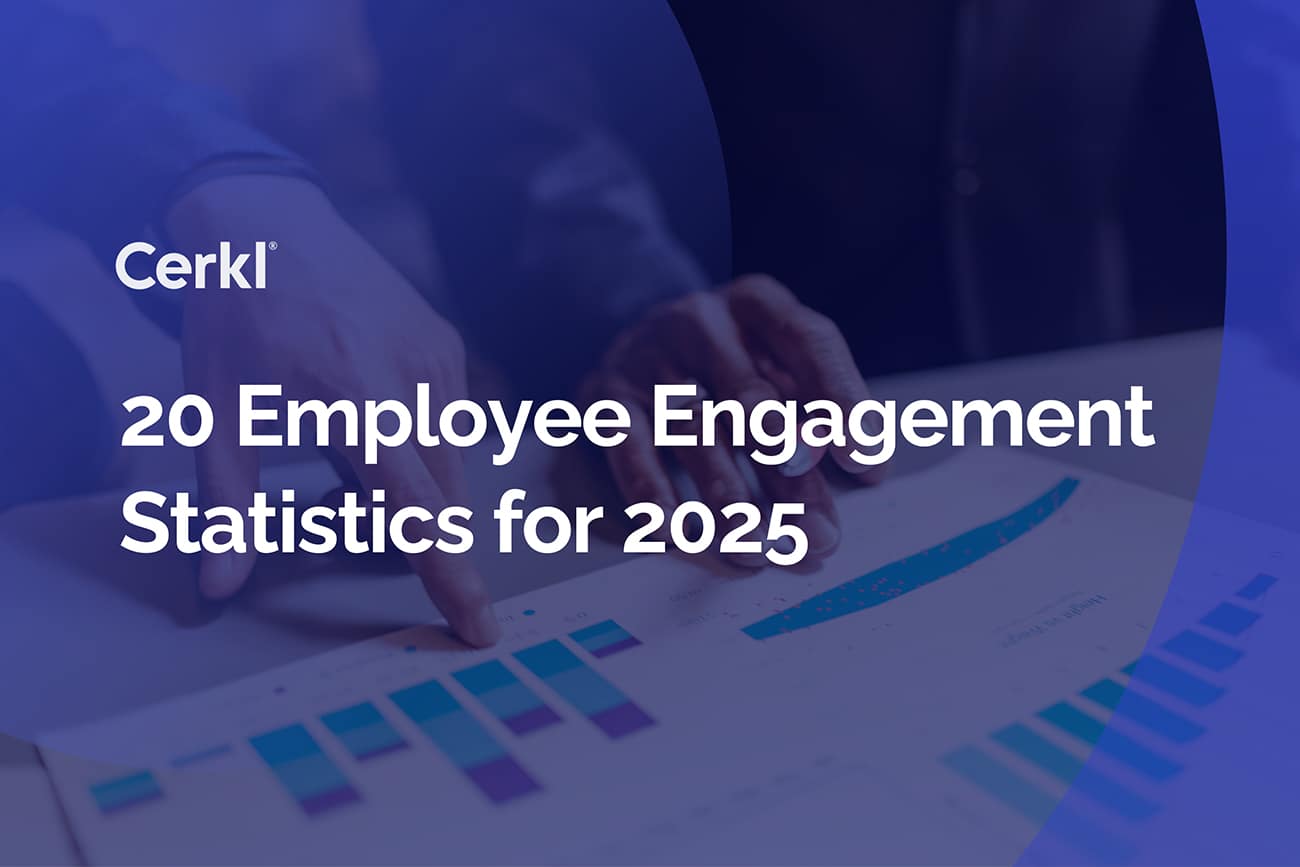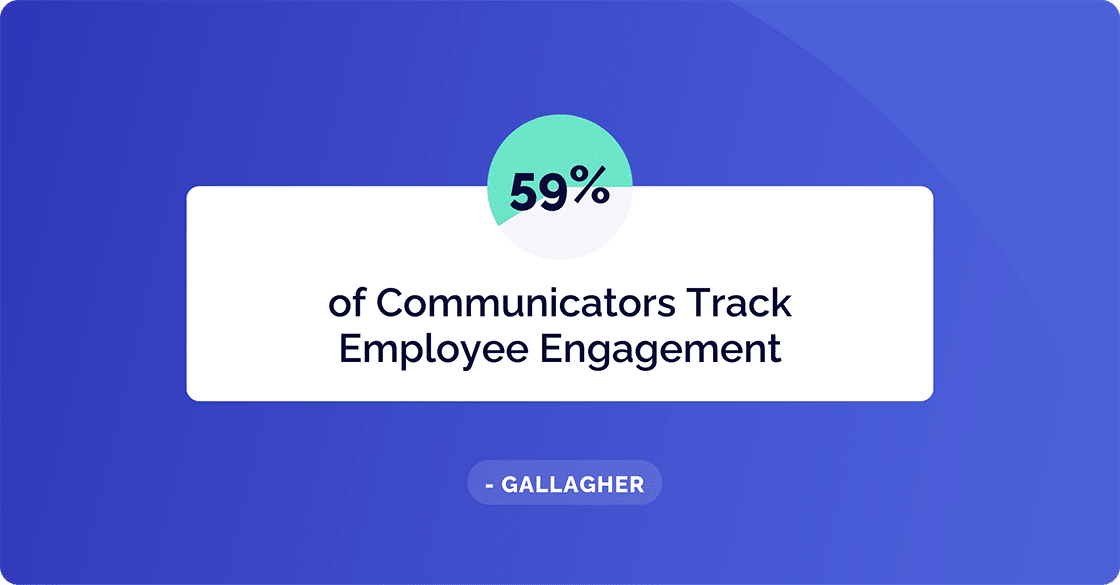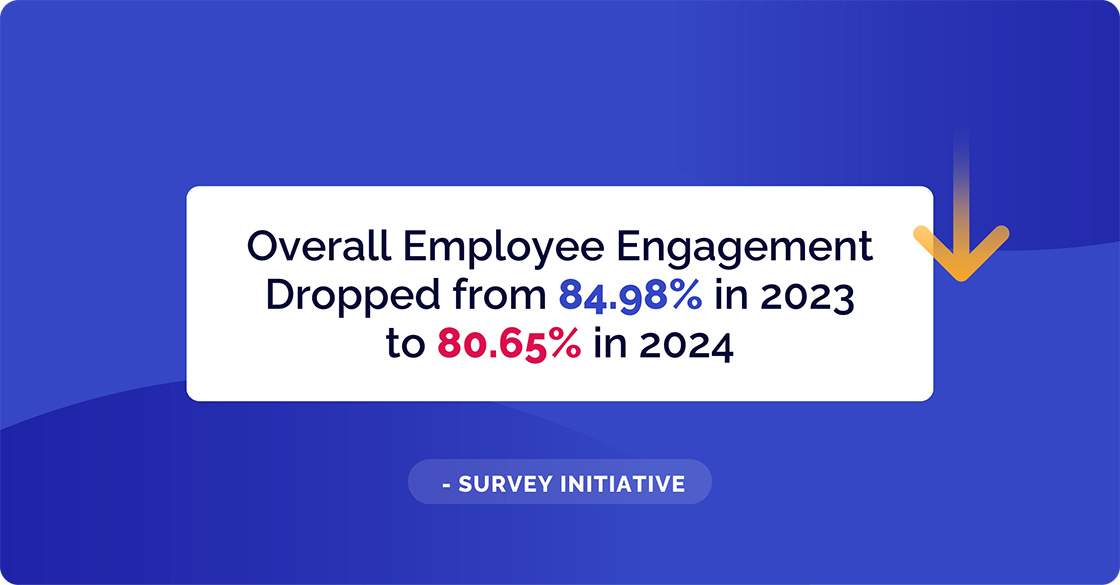20 Employee Engagement Statistics for 2025
Employee engagement statistics can help every type and size organization improve internal communications and company performance. Our stats are an eye-opener.

.png)
Increase Engagement With Meaningful Surveys
It can be difficult to know what to include in an employee survey. That’s why we have created a template that you can use for FREE to ensure your employee surveys are engaging. Get the responses that will help you understand your audience.
Access NowIt’s crucial for businesses to track employee engagement statistics. They provide valuable insights that can directly impact a company’s success. Knowledge of these statistics can also form the basis for a strategic approach to understanding your workforce and making data-driven decisions to improve your business.
Key benefits include improved business performance, reduced costs, and a way to create a positive work environment.
Gallup’s State of the Global Workplace: 2024 Report paints a daunting picture, with only 23% of employees globally classified as engaged. The report indicates that a significant portion of the global workforce (62%) is not engaged, and 15% are actively disengaged. While 34% are thriving, 58% are struggling, and 8% are suffering. This lack of emotional connection suggests a general lack of motivation and productivity within the global workforce.
Gallup started measuring global employee engagement in 2009, and they have continued to produce dependable data. In the graph below, based on Gallup’s published statistics, you can see that the percentage of employees who were engaged and thriving at work peaked in 2020, but has subsequently fallen close to its 2006-2007 levels. The actively disengaged level is currently on the increase.
Statistics in the Gallup 2024 report indicate that employee engagement varies from country to country. For example, 33% of employees are actively engaged at work in the U.S. and Canada, 32% in Latin America and the Caribbean, and 20% in sub-Saharan Africa. At present, according to Gallup, South Asia leads the world in employee engagement with 33% classified as being actively engaged. In Europe, only 13% of employees are thriving at work.
Their analysis of employees watching for or actively seeking a new job is also interesting. Topping the list are employees in sub-Saharan Africa (75%) vs 49% in the U.S. and Canada, and 32% in Europe.

Statistics that record employee engagement vary from country to country. For example, 31% of employees are actively engaged at work in the US and Canada, and 20% in sub-Saharan Africa. At present, according to Gallup, South Asia leads the world in employee engagement with 33% classified as being actively engaged. But in Europe, only 13% of employees are thriving at work.
Employees in South East Asia top the list of actively disengaged employees at 6%. In Australia and New Zealand, as well as Latin America and the Caribbean, this figure is 11%. The US/Canada and East Asian figure for actively disengaged employees is 17%, while at 15% it is slightly lower in Europe. In South Asia (amazingly), at 21%, it’s heading towards a quarter of employees who are actively disengaged.
What is Employee Engagement?
Employee engagement refers to the level of emotional connection, commitment, and enthusiasm employees have toward their work, colleagues, and the organization as a whole. Engaged employees are deeply invested in their roles. They demonstrate a genuine passion for their work and a willingness to go above and beyond to contribute to the success of the company.
Engaged employees are not only more productive, but they also contribute to higher levels of customer satisfaction, innovation, and profitability. They are more likely to remain loyal to the organization, reducing turnover rates and associated recruitment costs. Furthermore, engaged employees serve as brand ambassadors, positively impacting the company’s reputation both internally and externally.
A workplace culture that prioritizes employee engagement also attracts top talent. This is because job seekers are drawn to organizations where they feel valued, supported, and empowered to excel in their roles.
The Gallup 2024 report states that 54% of actively disengaged workers said they experienced “a lot of stress” the previous day. Overall, 41% of all employees globally said they had suffered a lot of stress the previous day. Fewer reported feeling sadness (22%), anger (21%), and loneliness (20%) - but the percentages are still relatively high.
It is important to track your employee engagement data and have fresh insights into your workforce activity. If you don’t have the capacity to do this, you can refer to other sources to get an idea of what to expect. With this in mind, we have prepared a list of 20 of the most interesting and useful employee engagement statistics you can use in your communication strategy or when talking about employee engagement in general.
[cerkl-cro-widget template_id="4"]
Where Do These Employee Engagement Statistics Come From?
We kicked off with statistics from Gallup, a major authority on the topic, and we have included several more stats from them. But there are many other reliable sources we are sharing with you, so read on. However, please be aware that different sources offer varied statistics based on their own research efforts.
For the record, we make sure our data is fresh and trustworthy by getting it directly from dependable sources. We’re serious about keeping our data accurate. We don’t use middlemen. We go right to the original sources like surveys, case studies, or research reports. This way, you can trust that the information we provide is the real deal.
Our stats are current. Don’t accept other posts that deliver data from sources that are five or 10 years old.
20 Employee Engagement Statistics for 2025
Most of these statistics are the result of surveys undertaken in 2023 or 2024. It takes time to do surveys and even more time to analyze them. They are invaluable because they enable us to look ahead and use the insights to improve employee engagement in our organizations.
#1 - 23% of the global workforce is highly engaged

Gallup’s State of the Global Workplace 2023 survey, on which the 2024 report is based, reveals that less than a quarter (23%) of the world’s employees were engaged at work, highlighting a growing trend of employee detachment from organizations. The percentage is higher for women (24%) and slightly lower (22%) for employees older than 35.
#2 - Low Engagement Costs the Global Economy $8.9 Trillion

According to Gallup, this huge cost accounts for 9% of the global GDP. It’s more than enough to make the difference between success and failure, not only for individual organizations but for world economies. It has increased by 1 trillion in the past year.
#3 - 29% of Those Working in Exclusively Remote Work Locations Are Engaged

The same Gallup source mentioned above shows that work location impacts employee engagement statistics. While only 20% of those working on-site are engaged, remote workers indicate 29% engagement, and hybrid workers 21%.
4# - 62% of Employees Are Not Engaged, While 15% Are Actively Disengaged

Active disengagement, which is also known as “loud quitting”, reached an all-time low of 13% in 2018 and 2019. Gallup’s 2023 report showed that this figure had risen to 18%, while the 2024 report shows it has fallen to 15%. Gallup presents strong evidence that decreasing numbers of disengaged employees drives positive outcomes including productivity, profitability, and higher sales.
5# - 93% of Organizations Hold Internal Communicators Responsible for Employee Engagement

According to Gallagher’s Employee Communications Report 2025, survey findings, there was a 74% rise in accountability. Of these, 79% were regarded as joint accountability and 14% as sole. Furthermore, 14% of HR and IC respondents indicated that internal comms was solely responsible for employee engagement.
6# - 59% of Communicators Track Employee Engagement

Even though globally, 71% of communicators in Gallagher’s 2024/25 survey regard employee engagement as the most important metric to track, only 59% of those in the US rank it tops. It is considerably higher in the UK, where 87% said they rate employee engagement statistics as the most important data to track.
7# - 92% of Executives Report an Increase in Performance

The Quantum Workplace 2024 Workplace Trends Report shows that in 2023, employee engagement declined for the first time in nearly a decade. While 92% of executives say they’ve seen an increase in employee performance due to their engagement efforts, their research indicates that when employees are disengaged, they are 2.6 times more likely to leave their company for a better culture. Nearly half (46%) want greater performance feedback.
8# - 41% of Employees Are Engaged at Organizations That Struggle to Communicate about Change

In the same report, Quantum Workplace warns that the frequency of organizational change doesn’t have any impact on employee engagement levels. Their research indicates that only 41% of employees are engaged at organizations that struggle to communicate about change. They also state that employees are 3.2 times more likely to be engaged when their performance goals are aligned with the organization’s goals.
9# - 60% of Employees Aren’t Getting On-the-Job Coaching and Engagement Needed to Support Core Job Skills

HR research by Gartner has found that there are critical gaps organizations need to reconcile to successfully pursue new strategic ambitions. Speaking at the Gartner ReimagineHR Conference held in October 2024, Jessie Knight, Research Vice President at Gartner, said that their research revealed only 29% of employees are satisfied with their collaboration at work. She highlighted dissatisfaction among employees who don’t feel equipped to respond to unexpected changes in their work. Furthermore, more than 60% of employees lack access to on-the-job coaching aligned with their essential job functions.
#10 - Organizations Can Increase Employee Productivity by up to 35% by Recognizing 4 Myths
A March 2025 press release issued by Gartner reveals four myths that the company says are hampering productivity. They are:
- Productivity isn’t an HR job
- Using AI leads to quick productivity growth
- Onsite employees are more productive than hybrid employees
- More data improves productivity

For example, their research shows that when organizations rely too heavily on quantitative data, aiming to improve productivity, they may omit non-digital labor and data that cannot be measured. This can “inadvertently encourage employees to game the system and negatively impact employee engagement.
However, organizations that take action on all four of these emerging myths can increase employee productivity by as much as 35%, says Gartner. This translates to individuals working 2.8 more hours per day and generating more than $47,000 in extra revenue every year.
#11 - 53% of Engaged Employees Are Comfortable with AI at Work, Vs 30% of Disengaged Employees

Qualtrics’ Employee Experience Trends 2024 reports that the more engaged employees are, the more willing they are to use AI at work. Their research points to 65% of senior C-suite employees being comfortable with AI, versus 46% of managers.
“Generally, the more positive you feel about your organization – the more trust you have in it – and the more senior your role, the more likely you are to believe that your organization will use AI for your benefit.”
Sarah Marrs, Qualtrics Director of EX Strategy Execution
#12 - Overall Employee Engagement Shifted By 4.33% From 2023 to 2024

According to The Survey Initiative’s Employee Engagement 2024 Trends, employee engagement dropped from 84.98% in 2023 to 80.65% in 2024. This indicates an overall decline of 4.33%. As they state, negative shifts in engagement can have significant consequences, leading to lower morale, decreased performance, and higher turnover. The biggest shift was in pride, which dropped from 89.5% to 86.41%, followed by employees’ intent to stay with the organization — which reduced from 87.008% to 84.03%. Advocacy reduced from 81.79% to 77.02% while motivation dropped from 81.55% to 75.13%.
#13 - Expect a 24% Increase in Engagement Levels When Leadership Plays a Critical Role

Effectory’s Global Employee Engagement Index, which examines benchmarks, trends, and strategies to improve employee engagement in 2025, identifies the importance of leadership in employee engagement levels. It reveals that this key driver increases alignment by 22.5%, employee retention by 20.6%, customer focus by 19.9%, and productivity by 19.3%. When leadership plays a critical role, it can increase by about 24%.
#14 - Globally, Employee Engagement Levels Range From 67.1% to 12.1%

Effectory’s research also shows that employee benchmarks vary hugely from 67.1% for India to 12.1% for Japan. They peg the U.S. at 46.3%, which is higher than the Gallup figure.
#15 - 70% of How Much a Team Is Engaged is Determined Solely by the Manager

Managers are responsible for clarifying work expectations, providing support and advocacy for employees as needed. This highlights how significant their work is in relation to achieving organizational goals. However, many managers struggle to initiate regular discussions that are meaningful. This can make employees see their actions as micromanagement instead of offering proper guidance and resources. Unfortunately, this hampers their ability to guide and support teams effectively.
According to Gallup, 70% of the variance in team engagement is determined by the manager alone.
#16 - The engagement of workers younger than 35 rose two points in 2024 but is still five points behind its peak level of 40% in 2020

Gallup’s chief scientist of Workplace Management and Wellbeing, Jim Harter made this statement in a 2024 Workplace post, In New Workplace, U.S. Employee Engagement Stagnates.
He states that only 45% of employees clearly know what is expected of them at work. Younger workers have improved by seven percentage points in terms of clarity of expectations, but they are still seven points behind the 2020 pre-pandemic levels.
#17 - 63% of Employees Rate Four-Day Workweeks as a Top Reason to Take a New Job

According to Gartner’s 9 Future of Work Trends for 2024, a four-day workweek, takes the concept “from radical to routine.” This makes it the top new, innovative benefit that will attract employees to a new job.
#18 - Employees Who Are Recognized Are 45% Less Likely to Leave Within 2 Years

Vantage Circle’s 2024 Employee Spotlight shows how fostering a positive workplace culture increases employee engagement and retention. Data they have researched indicates that employees who are recognized are 45% less likely to leave within two years. Those who feel their organizations recognize their talents and promote skill development are 47% less likely to seek new job opportunities.
#19 - 65% of Employees Regard Workplace Flexibility as the Top Benefit

While according to The Conference Board, a competitive salary is the most important factor for employees, workplace flexibility ranks second. In a press release issued in February 2025, Diana Scott, Leader of the Human Capital Center at The Conference Board, states that the more flexibility offered, the higher the employee retention will be. These statistics are based on surveys and studies conducted by The Conference Board.
“Making employee retention a staple of your talent strategy can provide a competitive edge — preserving institutional knowledge, cultivating a pipeline of future leaders, and increasing employee engagement. Doing so will save organizations a lot of the time and money they currently spend on attracting talent.”
Diana Scott
#20 - 50% of Employees Will Consider Leaving A Job If They Don’t Get the Development Opportunities They Need

A key differentiator between employees with a low intent to stay and those with a high intent to stay is the availability of growth opportunities, says The Conference Board.
They maintain that investing in an internal talent marketplace is a strategic catalyst for growth and development opportunities.
What’s Next?
You’ve read about the global statistics that relate to employee engagement. How do the metrics from your organization compare? Do you know?
A lot has to do with your internal communication strategy. Do you know whether it’s working for your business? Do you make an active attempt to collect employee feedback and measure employee engagement on an ongoing basis?
We’ve created an employee engagement survey template that will help you do this – and it’s free for you to use. It’ll help find out whether employees in your organization are engaged and feeling happy and fulfilled in their roles. You can use the survey template as is, or adapt it to meet more specific needs.
[cerkl-cro-widget type="compact" template_id="4"]
If it turns out that your communications strategy isn’t working too well, Cerkl Broadcast has solutions you may not even realize exist. Don’t hold back. We’re ready to help you turn your internal communications around. With our free employee engagement survey template, you can craft effective surveys to measure employee sentiment and boost engagement.
FAQ
Why is employee engagement important? Employee engagement is crucial because engaged workers are more productive and profitable. They also deliver better customer service, leading to a stronger business.
What are actively disengaged employees? As Gallup tells us, actively disengaged employees are unhappy and uninvested in their work. They are more likely to be negative influences on colleagues and put less effort into their tasks.
What do employee engagement statistics teach us? Employee engagement statistics show a clear connection between happy, motivated employees and an organization's success. They point to areas where companies can improve work culture and practices to retain top talent and achieve better results.
Free Employee Engagement Survey Template to Boost Productivity
Craft effective surveys to measure employee sentiment and boost engagement
.png)
Download Free
Free Employee Engagement Survey Template to Boost Productivity
Craft effective surveys to measure employee sentiment and boost engagement
.png)
Download Free
.png)
Free Employee Engagement Survey Template to Boost Productivity
Craft effective surveys to measure employee sentiment and boost engagement







.png)
.png)
.png)